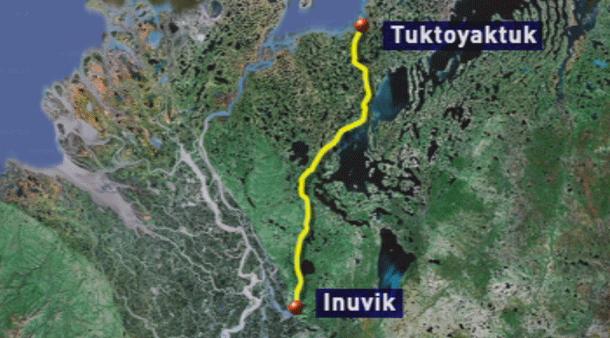Blog: The geometries of Arctic all-weather road construction

2015 marks the third season of construction along the Inuvik-Tuktoyaktuk all-weather road.
That means it’s possible to watch construction of the road from space unfold over a three-year period, seen in this satellite image time-lapse. This $300 million, 140-kilometer road will permanently link Tuktoyaktuk, a hamlet on the Arctic Ocean in Canada’s Northwest Territories, with the town of Inuvik to the south – and with it, the Dempster Highway. Currently, Tuktokyaktuk is only connected by land to the rest of Canada during winter, when an ice road to Inuvik is maintained on the Mackenzie River. Once the all-weather road is complete, the ice road will no longer be maintained as Canada’s permanent road system will finally extend all the way to the Arctic Ocean. Anyone with a driver’s license will be able to drive from the Pacific to the Arctic to the Atlantic to the Great Lakes. Talk about a three-ocean road trip. As the government website boasts,
“This road, which extends the Dempster Highway to the Arctic coast, will complete Canada’s road network from coast to coast to coast. It will strengthen Canada’s Arctic presence and contribute to economic and social development in the North.”
I’ve written before that one largely unstated reason behind the road’s construction may have to do with the oil and gas deposits offshore Tuktoyaktuk, in the Mackenzie Delta. When the road was approved in 2011, oil prices were high. Now, they are so low that many Arctic oil and gas development projects have been shelved. Chevron, which holds one of the leases in the Mackenzie Delta, announced in December 2014 that it would put its plans for its EL 481 block “on hold indefinitely.”
Oil prices, erosion, fossil fuels
But neither the federal nor territorial government can turn their backs on the road now. In any case, Canadian sovereignty and presence in the Arctic is at stake, so progress continues. After all, the price of oil may rise again one day. If and when the day comes that oil and gas are drilled offshore in the Mackenzie Delta, oil companies will save hundreds of millions of dollars in transportation costs thanks to the road to Tuk. Local residents, meanwhile, will save a mere $1.5 million, although, as the government likes to celebrate, they’ll have improved mobility and connections to the rest of Canada. They will also benefit from the hundreds of (temporary) jobs that have been created during construction. Seen otherwise, however, this road represents the permanent encroachment of fossil-fueled development into the earth’s northernmost frontiers. Roads like this also embody both the naïveté and narcissism of humans, for the government is deigning to build the road even as Tuktoyaktuk slides downward and seaward due to melting permafrost and coastal erosion.
The strip of sovereignty-streaked asphalt continues to wind its way south, with progress going faster from the Tuktoyaktuk side than the Inuvik side due to the slightly flatter and colder conditions up north, which facilitate construction. The two ends of the road should meet somewhere in the middle by next year, with construction being completed during the 2017/2018 season. A CBC News story has more details on the difficulties and delays facing construction crews. It also has the factoid that “1.9 million cubic metres of dirt” have been moved so far during construction. Yet this number is just a bunch of zeroes unless it is compared with other projects across human history. So how does the Inuvik-Tuktoyaktuk road stack up?
- Over 1000 years, in approximately 100 different limestone quarries, inhabitants of ancient Corinth (in present-day Greece) removed 1.9 million cubic meters of stone.
- In two years, from 2007-2009, the Finnish port of Raahe dredged 1.9 million cubic meters of soil to create a deep-water channel and harbor.
- Every day in 2013, China produced 2 million cubic meters of shale gas.
In other words, it took the Ancient Greeks a thousand years to move the amount of earth that has been moved in just three short winters in an extremely inhospitable environment. The exponential compression of the amount of time needed to move huge quantities of earthern material brings to mind those charts that illustrate almost every index of human development shooting up in a straight line after 1950 or so.
Moving earth
The 1.9 million cubic meters of gravel that have been moved near Tuktoyaktuk and Inuvik are more than just “dirt.” In a boggy, permafrost-laden tundra like the northern Northwest Territories, this material is a precious commodity. The negotiators of the Inuvialuit Final Agreement, the treaty signed in 1984 between the Canadian government and the indigenous Inuvialuit, who inhabit the area around the Mackenzie Delta, had enough foresight to include a regulation detailing the royalties that the government would pay the Inuvialuit in the case that it wanted to use some of their gravel. The Inuvialuit Settlement Region, in which the road is located, even has a Granular Resources Management Plan. The document states that the Inuvialuit and the Government of Canada both recognize the importance of the “effective use of finite gravel resources in one of the most geographically remote places in Canada.” Settlement of the royalties paid by the government for the gravel removed from Inuvialuit private lands was, in fact, one of the final obstacles that had to be cleared before road construction could begin.
Aside from moving politically and environmentally sensitive earth, the construction crews must know how to build on top of earth that literally is moving. That’s because permafrost underlies this corner of the Northwest Territories. In the summer, the white expanses give way to a pockmarked landscape of lakes and tundra. The road is therefore being built at an elevated level slightly above the permafrost. The image above may remind some readers of the landscape in the Yamal Peninsula, where a giant crater opened up in the earth last year. Looking at the Mackenzie Delta in this satellite image, it seems impossible to determine where to begin even drawing a road in a world that looks like Swiss cheese – but somehow, the Canadian engineers have done it. Where there’s a will, there’s an all-weather way that takes into account everything above and below ground – and whose results can be seen from space.
Correction: The cost of the road construction to Tuktoyaktuk is $300-million, not $150-million as stated in a previous version of this story.
This post first appeared on Cryopolitics, an Arctic News and Analysis blog.
Related stories from around the North:
Asia: China’s silk road plans could challenge Northern Sea Route, Blog by Mia Bennett
Canada: Driving on the ice road in Canada’s Northwest Territories, Eye on the Arctic
Finland: Winter speed limits coming into force in Finland, Yle News
Norway: A railroad of dreams and nightmares across Arctic Norway, Blog by Mia Bennett
Russia: Murmansk, Russia: Transport hub trouble, again, Barents Observer
Sweden: Motorists warned to watch out for wildlife on Sweden’s roads, Radio Sweden
United States: High temperatures sink vehicles traveling ice roads in Western Alaska, Alaska Dispatch News




